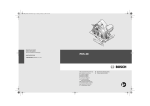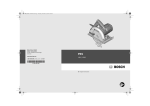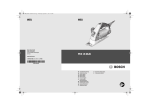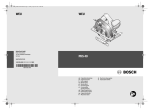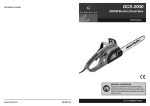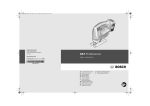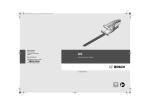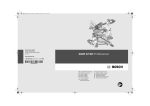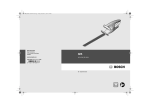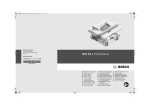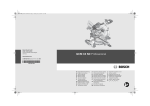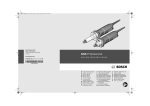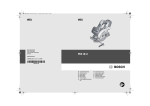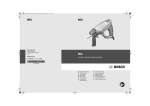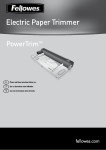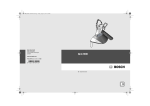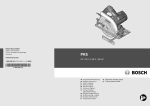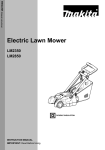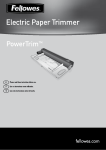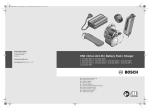Download WEU WEU PKS 16 Multi - Tooled
Transcript
OBJ_DOKU-32902-003.fm Page 1 Wednesday, September 11, 2013 4:42 PM WEU Robert Bosch GmbH Power Tools Division 70745 Leinfelden-Echterdingen Germany WEU PKS 16 Multi www.bosch-pt.com 1 609 92A 0GB (2013.09) O / 119 WEU de en fr es pt it nl Originalbetriebsanleitung Original instructions Notice originale Manual original Manual original Istruzioni originali Oorspronkelijke gebruiksaanwijzing da Original brugsanvisning sv Bruksanvisning i original no Original driftsinstruks fi Alkuperäiset ohjeet el tr Πρωτότυπο οδηγιών χρήσης Orijinal işletme talimatı OBJ_BUCH-1837-003.book Page 3 Wednesday, September 11, 2013 4:24 PM |3 1 2 9 8 3 4 7 6 5 10 11 PKS 16 Multi Bosch Power Tools 1 609 92A 0GB | (11.9.13) OBJ_BUCH-1837-003.book Page 4 Wednesday, September 11, 2013 4:24 PM 4| A 16 15 21 14 13 3 4 12 B C 1 8 2 5 1 609 92A 0GB | (11.9.13) Bosch Power Tools OBJ_BUCH-1837-003.book Page 5 Wednesday, September 11, 2013 4:24 PM |5 D 14 E 20 17 9 19 7 18 Bosch Power Tools 1 609 92A 0GB | (11.9.13) OBJ_BUCH-1837-003.book Page 15 Wednesday, September 11, 2013 4:24 PM English | 15 Nur für EU-Länder: Gemäß der Europäischen Richtlinie 2012/19/EU über Elektro- und ElektronikAltgeräte und ihrer Umsetzung in nationales Recht müssen nicht mehr gebrauchsfähige Elektrowerkzeuge getrennt gesammelt und einer umweltgerechten Wiederverwertung zugeführt werden. Änderungen vorbehalten. English Safety Notes General Power Tool Safety Warnings Read all safety warnings and all instructions. Failure to follow the warnings and instructions may result in electric shock, fire and/or serious injury. Save all warnings and instructions for future reference. The term “power tool” in the warnings refers to your mainsoperated (corded) power tool or battery-operated (cordless) power tool. WARNING Work area safety Keep work area clean and well lit. Cluttered or dark areas invite accidents. Do not operate power tools in explosive atmospheres, such as in the presence of flammable liquids, gases or dust. Power tools create sparks which may ignite the dust or fumes. Keep children and bystanders away while operating a power tool. Distractions can cause you to lose control. Electrical safety Power tool plugs must match the outlet. Never modify the plug in any way. Do not use any adapter plugs with earthed (grounded) power tools. Unmodified plugs and matching outlets will reduce risk of electric shock. Avoid body contact with earthed or grounded surfaces, such as pipes, radiators, ranges and refrigerators. There is an increased risk of electric shock if your body is earthed or grounded. Do not expose power tools to rain or wet conditions. Water entering a power tool will increase the risk of electric shock. Do not abuse the cord. Never use the cord for carrying, pulling or unplugging the power tool. Keep cord away from heat, oil, sharp edges and moving parts. Damaged or entangled cords increase the risk of electric shock. When operating a power tool outdoors, use an extension cord suitable for outdoor use. Use of a cord suitable for outdoor use reduces the risk of electric shock. Bosch Power Tools If operating a power tool in a damp location is unavoidable, use a residual current device (RCD) protected supply. Use of an RCD reduces the risk of electric shock. Personal safety Stay alert, watch what you are doing and use common sense when operating a power tool. Do not use a power tool while you are tired or under the influence of drugs, alcohol or medication. A moment of inattention while operating power tools may result in serious personal injury. Use personal protective equipment. Always wear eye protection. Protective equipment such as dust mask, non-skid safety shoes, hard hat, or hearing protection used for appropriate conditions will reduce personal injuries. Prevent unintentional starting. Ensure the switch is in the off-position before connecting to power source and/or battery pack, picking up or carrying the tool. Carrying power tools with your finger on the switch or energising power tools that have the switch on invites accidents. Remove any adjusting key or wrench before turning the power tool on. A wrench or a key left attached to a rotating part of the power tool may result in personal injury. Do not overreach. Keep proper footing and balance at all times. This enables better control of the power tool in unexpected situations. Dress properly. Do not wear loose clothing or jewellery. Keep your hair, clothing and gloves away from moving parts. Loose clothes, jewellery or long hair can be caught in moving parts. If devices are provided for the connection of dust extraction and collection facilities, ensure these are connected and properly used. Use of dust collection can reduce dust-related hazards. Power tool use and care Do not force the power tool. Use the correct power tool for your application. The correct power tool will do the job better and safer at the rate for which it was designed. Do not use the power tool if the switch does not turn it on and off. Any power tool that cannot be controlled with the switch is dangerous and must be repaired. Disconnect the plug from the power source and/or the battery pack from the power tool before making any adjustments, changing accessories, or storing power tools. Such preventive safety measures reduce the risk of starting the power tool accidentally. Store idle power tools out of the reach of children and do not allow persons unfamiliar with the power tool or these instructions to operate the power tool. Power tools are dangerous in the hands of untrained users. Maintain power tools. Check for misalignment or binding of moving parts, breakage of parts and any other condition that may affect the power tool’s operation. If damaged, have the power tool repaired before use. Many accidents are caused by poorly maintained power tools. 1 609 92A 0GB | (11.9.13) OBJ_BUCH-1837-003.book Page 16 Wednesday, September 11, 2013 4:24 PM 16 | English Keep cutting tools sharp and clean. Properly maintained cutting tools with sharp cutting edges are less likely to bind and are easier to control. Use the power tool, accessories and tool bits etc. in accordance with these instructions, taking into account the working conditions and the work to be performed. Use of the power tool for operations different from those intended could result in a hazardous situation. Service Have your power tool serviced by a qualified repair person using only identical replacement parts. This will ensure that the safety of the power tool is maintained. Safety Warnings for Circular Saws Cutting procedures DANGER: Keep hands away from cutting area and the blade. Keep your second hand on auxiliary handle, or motor housing. If both hands are holding the saw, they cannot be cut by the blade. Do not reach underneath the workpiece. The guard cannot protect you from the blade below the workpiece. Adjust the cutting depth to the thickness of the workpiece. Less than a full tooth of the blade teeth should be visible below the workpiece. Never hold piece being cut in your hands or across your leg. Secure the workpiece to a stable platform. It is important to support the work properly to minimize body exposure, blade binding, or loss of control. Hold the power tool by the insulated gripping surfaces only, when performing an operation where the cutting tool may contact hidden wiring or its own cord. Contact with a “live” wire will also make exposed metal parts of the power tool “live” and could give the operator an electric shock. When ripping always use a rip fence or straight edge guide. This improves the accuracy of cut and reduces the chance of blade binding. Always use blades with correct size and shape (diamond versus round) of arbour holes. Blades that do not match the mounting hardware of the saw will run eccentrically, causing loss of control. Never use damaged or incorrect blade washers or bolt. The blade washers and bolt were specially designed for your saw, for optimum performance and safety of operation. Kickback causes and related warnings – Kickback is a sudden reaction to a pinched, bound or misaligned saw blade, causing an uncontrolled saw to lift up and out of the workpiece toward the operator; – When the blade is pinched or bound tightly by the kerf closing down, the blade stalls and the motor reaction drives the unit rapidly back toward the operator; – If the blade becomes twisted or misaligned in the cut, the teeth at the back edge of the blade can dig into the top surface of the wood causing the blade to climb out of the kerf and jump back toward the operator. 1 609 92A 0GB | (11.9.13) Kickback is the result of saw misuse and/or incorrect operating procedures or conditions and can be avoided by taking proper precautions as given below. Maintain a firm grip with both hands on the saw and position your arms to resist kickback forces. Position your body to either side of the blade, but not in line with the blade. Kickback could cause the saw to jump backwards, but kickback forces can be controlled by the operator, if proper precautions are taken. When blade is binding, or when interrupting a cut for any reason, release the trigger and hold the saw motionless in the material until the blade comes to a complete stop. Never attempt to remove the saw from the work or pull the saw backward while the blade is in motion or kickback may occur. Investigate and take corrective actions to eliminate the cause of blade binding. When restarting a saw in the workpiece, centre the saw blade in the kerf and check that saw teeth are not engaged into the material. If saw blade is binding, it may walk up or kickback from the workpiece as the saw is restarted. Support large panels to minimise the risk of blade pinching and kickback. Large panels tend to sag under their own weight. Supports must be placed under the panel on both sides, near the line of cut and near the edge of the panel. Do not use dull or damaged blades. Unsharpened or improperly set blades produce narrow kerf causing excessive friction, blade binding and kickback. Blade depth and bevel adjusting locking levers must be tight and secure before making cut. If blade adjustment shifts while cutting, it may cause binding and kickback. Use extra caution when sawing into existing walls or other blind areas. The protruding blade may cut objects that can cause kickback. Guard function Check guard for proper closing before each use. Do not operate the saw if guard does not move freely and enclose the blade instantly. Never clamp or tie the guard so that the blade is exposed. If saw is accidentally dropped, guard may be bent. Check to make sure that guard moves freely and does not touch the blade or any other part, in all angles and depths of cut. Check the operation and condition of the guard return spring. If the guard and the spring are not operating properly, they must be serviced before use. Guard may operate sluggishly due to damaged parts, gummy deposits, or a build-up of debris. Assure that the base plate of the saw will not shift while performing the “plunge cut” when the blade bevel setting is not at 90°. Blade shifting sideways will cause binding and likely kick back. Always observe that the guard is covering the blade before placing saw down on bench or floor. An unprotected, coasting blade will cause the saw to walk backwards, cutting whatever is in its path. Be aware of the time it takes for the blade to stop after switch is released. Bosch Power Tools OBJ_BUCH-1837-003.book Page 17 Wednesday, September 11, 2013 4:24 PM English | 17 Cut-off machine safety warnings The guard provided with the tool must be securely attached to the power tool and positioned for maximum safety, so the least amount of wheel is exposed towards the operator. Position yourself and bystanders away from the plane of the rotating wheel. The guard helps to protect operator from broken wheel fragments and accidental contact with wheel. Use only diamond cut-off wheels for your power tool. Just because an accessory can be attached to your power tool, it does not assure safe operation. The rated speed of the accessory must be at least equal to the maximum speed marked on the power tool. Accessories running faster than their rated speed can break and fly apart. Wheels must be used only for recommended applications. For example: do not grind with the side of cut-off wheel. Abrasive cut-off wheels are intended for peripheral grinding, side forces applied to these wheels may cause them to shatter. Always use undamaged wheel flanges that are of correct diameter for your selected wheel. Proper wheel flanges support the wheel thus reducing the possibility of wheel breakage. The outside diameter and the thickness of your accessory must be within the capacity rating of your power tool. Incorrectly sized accessories cannot be adequately guarded or controlled. The arbour size of wheels and flanges must properly fit the spindle of the power tool. Wheels and flanges with arbour holes that do not match the mounting hardware of the power tool will run out of balance, vibrate excessively and may cause loss of control. Do not use damaged wheels. Before each use, inspect the wheels for chips and cracks. If power tool or wheel is dropped, inspect for damage or install an undamaged wheel. After inspecting and installing the wheel, position yourself and bystanders away from the plane of the rotating wheel and run the power tool at maximum no load speed for one minute. Damaged wheels will normally break apart during this test time. Wear personal protective equipment. Depending on application, use face shield, safety goggles or safety glasses. As appropriate, wear dust mask, hearing protectors, gloves and shop apron capable of stopping small abrasive or workpiece fragments. The eye protection must be capable of stopping flying debris generated by various operations. The dust mask or respirator must be capable of filtrating particles generated by your operation. Prolonged exposure to high intensity noise may cause hearing loss. Keep bystanders a safe distance away from work area. Anyone entering the work area must wear personal protective equipment. Fragments of workpiece or of a broken accessory may fly away and cause injury beyond immediate area of operation. Hold the power tool by insulated gripping surfaces only, when performing an operation where the cutting Bosch Power Tools accessory may contact hidden wiring or its own cord. Cutting accessory contacting a “live” wire may make exposed metal parts of the power tool “live” and could give the operator an electric shock. Position the cord clear of the spinning accessory. If you lose control, the cord may be cut or snagged and your hand or arm may be pulled into the spinning wheel. Never lay the power tool down until the accessory has come to a complete stop. The spinning wheel may grab the surface and pull the power tool out of your control. Do not run the power tool while carrying it at your side. Accidental contact with the spinning accessory could snag your clothing, pulling the accessory into your body. Regularly clean the power tool’s air vents. The motor’s fan will draw the dust inside the housing and excessive accumulation of powdered metal may cause electrical hazards. Do not operate the power tool near flammable materials. Sparks could ignite these materials. Do not use accessories that require liquid coolants. Using water or other liquid coolants may result in electrocution or shock. Kickback and related warnings Kickback is a sudden reaction to a pinched or snagged rotating wheel. Pinching or snagging causes rapid stalling of the rotating wheel which in turn causes the uncontrolled power tool to be forced in the direction opposite of the wheel’s rotation at the point of the binding. For example, if an abrasive wheel is snagged or pinched by the workpiece, the edge of the wheel that is entering into the pinch point can dig into the surface of the material causing the wheel to climb out or kick out. The wheel may either jump toward or away from the operator, depending on direction of the wheel’s movement at the point of pinching. Abrasive wheels may also break under these conditions. Kickback is the result of power tool misuse and/or incorrect operating procedures or conditions and can be avoided by taking proper precautions as given below. Maintain a firm grip on the power tool and position your body and arm to allow you to resist kickback forces. Always use auxiliary handle, if provided, for maximum control over kickback or torque reaction during start-up. The operator can control torque reactions or kickback forces, if proper precautions are taken. Never place your hand near the rotating accessory. Accessory may kickback over your hand. Do not position your body in line with and behind the rotating wheel. When the wheel, at the point of operation, is moving away from your body, the possible kickback may propel the spinning wheel and the power tool directly at you. Use special care when working corners, sharp edges, etc. Avoid bouncing and snagging the accessory. Corners, sharp edges or bouncing have a tendency to snag the rotating accessory and cause loss of control or kickback. Do not attach a saw chain, woodcarving blade, segmented diamond wheel with a peripheral gap greater 1 609 92A 0GB | (11.9.13) OBJ_BUCH-1837-003.book Page 18 Wednesday, September 11, 2013 4:24 PM 18 | English than 10 mm or toothed saw blade. Such blades create frequent kickback and loss of control. Do not “jam” the cut-off wheel or apply excessive pressure. Do not attempt to make an excessive depth of cut. Overstressing the wheel increases the loading and susceptibility to twisting or binding of the wheel in the cut and the possibility of kickback or wheel breakage. When wheel is binding or when interrupting a cut for any reason, switch off the power tool and hold the power tool motionless until the wheel comes to a complete stop. Never attempt to remove the cut-off wheel from the cut while the wheel is in motion otherwise kickback may occur. Investigate and take corrective action to eliminate the cause of wheel binding. Do not restart the cutting operation in the workpiece. Let the wheel reach full speed and carefully re-enter the cut. The wheel may bind, walk up or kickback if the power tool is restarted in the workpiece. Support panels or any oversized workpiece to minimize the risk of wheel pinching and kickback. Large workpieces tend to sag under their own weight. Supports must be placed under the workpiece near the line of cut and near the edge of the workpiece on both sides of the wheel. Use extra caution when making a “pocket cut” into existing walls or other blind areas. The protruding wheel may cut gas or water pipes, electrical wiring or objects that can cause kickback. Wear safety goggles. Use clamps or another practical way to secure and support the workpiece to a stable platform. Holding the work by your hand or against the body leaves it unstable and may lead to loss of control. Wear hearing protection, safety goggles, dust mask and gloves. As dust mask, use at least a particle filtering half mask of filter class FFP 2. Additional safety warnings When working stone, use dust extraction. The vacuum cleaner must be approved for the extraction of stone dust. Using this equipment reduces dust-related hazards. When working with the machine, always hold it firmly with both hands and provide for a secure stance. The power tool is guided more secure with both hands. Secure the workpiece. A workpiece clamped with clamping devices or in a vice is held more secure than by hand. Never use the machine with a damaged cable. Do not touch the damaged cable and pull the mains plug when the cable is damaged while working. Damaged cables increase the risk of an electric shock. Do not reach into the saw dust ejector with your hands. They could be injured by rotating parts. 1 609 92A 0GB | (11.9.13) Do not work overhead with the power tool. Sufficient control of the power tool is not ensured in this working manner. Use suitable detectors to determine if utility lines are hidden in the work area or call the local utility company for assistance. Contact with electric lines can lead to fire and electric shock. Damaging a gas line can lead to explosion. Penetrating a water line causes property damage or may cause an electric shock. Do not operate the power tool stationary. It is not designed for operation with a saw table. Do not use high speed steel (HSS) saw blades. Such saw blades can easily break. Do not saw ferrous metals. Red hot chips can ignite the dust extraction. Always wait until the machine has come to a complete stop before placing it down. The tool insert can jam and lead to loss of control over the power tool. Products sold in GB only: Your product is fitted with an BS 1363/A approved electric plug with internal fuse (ASTA approved to BS 1362). If the plug is not suitable for your socket outlets, it should be cut off and an appropriate plug fitted in its place by an authorised customer service agent. The replacement plug should have the same fuse rating as the original plug. The severed plug must be disposed of to avoid a possible shock hazard and should never be inserted into a mains socket elsewhere. Products sold in AUS and NZ only: Use a residual current device (RCD) with a rated residual current of 30 mA or less. Product Description and Specifications Read all safety warnings and all instructions. Failure to follow the warnings and instructions may result in electric shock, fire and/or serious injury. Intended Use The power tool is intended for making straight lengthways and crossways cuts in wood while resting firmly against the material being sawn. With appropriate saw blades, thinwalled non-ferrous metals or plastics, such as profiles, can also be sawn. With appropriate diamond cutting discs, tiles can be cut without the use of water. Working ferrous metals is not permitted. Product Features The numbering of the product features refers to the illustration of the machine on the graphics page. 1 Lock-off button for On/Off switch 2 On/Off switch 3 Base plate 4 Release lever for base plate 5 Slider for cutting-depth preselection Bosch Power Tools OBJ_BUCH-1837-003.book Page 19 Wednesday, September 11, 2013 4:24 PM English | 19 6 7 8 9 10 11 12 13 14 15 16 17 18 19 20 21 2 Cutting guard “CutControl” – Viewing window for cutting line Screw for depth-of-cut adjustment Extraction adapter Auxiliary gripping surface (insulated) Handle (insulated gripping surface) Spindle lock button Mounting flange Saw blade* Clamping bolt with clamping flange Allen key Vacuum hose* Set of screw clamps* Cutting mark Sawdust ejector Diamond cutting disc* *Accessories shown or described are not part of the standard delivery scope of the product. A complete overview of accessories can be found in our accessories program. Technical Data Circular Saw Article number Rated power input No-load speed Base plate dimensions Mounting bore Weight according to EPTA-Procedure 01/2003 Protection class Cutting depth, max. Saw blade diameter, max. Saw blade diameter, min. Blade thickness, max. Tooth thickness/setting, max. Tooth thickness/setting, min. Max. diameter for diamond cutting discs Working with one diamond cutting disc – Cutting discs width, min. – Cutting discs width, max. PKS 16 Multi 3 603 CB3 0.. W 400 min-1 6400 mm 68 x 233 mm 15 kg mm mm mm mm mm mm 1.9 / II 16 65 65 1.2 2.0 0.8 mm 65 mm mm 0.6 1.2 The values given are valid for a nominal voltage [U] of 230 V. For different voltages and models for specific countries, these values can vary. Noise/Vibration Information Measured sound values determined according to EN 60745. Typically the A-weighted noise levels of the product are: Sound pressure level 97 dB(A); Sound power level 108 dB(A). Uncertainty K =3 dB. Wear hearing protection! Vibration total values ah (triax vector sum) and uncertainty K determined according to EN 60745: Bosch Power Tools 2 Sawing wood: ah <2.5 m/s , K=1.5 m/s , Sawing metal: ah <2.5 m/s2, K=1.5 m/s2, Cutting tiles: ah =2.5 m/s2, K=1.5 m/s2. The vibration level given in this information sheet has been measured in accordance with a standardised test given in EN 60745 and may be used to compare one tool with another. It may be used for a preliminary assessment of exposure. The declared vibration emission level represents the main applications of the tool. However if the tool is used for different applications, with different accessories or insertion tools or is poorly maintained, the vibration emission may differ. This may significantly increase the exposure level over the total working period. An estimation of the level of exposure to vibration should also take into account the times when the tool is switched off or when it is running but not actually doing the job. This may significantly reduce the exposure level over the total working period. Identify additional safety measures to protect the operator from the effects of vibration such as: maintain the tool and the accessories, keep the hands warm, organisation of work patterns. Declaration of Conformity We declare under our sole responsibility that the product described under “Technical Data” is in conformity with the following standards or standardization documents: EN 60745 according to the provisions of the directives 2011/65/EU, 2004/108/EC, 2006/42/EC. Technical file (2006/42/EC) at: Robert Bosch GmbH, PT/ETM9 D-70745 Leinfelden-Echterdingen Henk Becker Helmut Heinzelmann Executive Vice President Head of Product Certification Engineering PT/ETM9 Robert Bosch GmbH, Power Tools Division D-70745 Leinfelden-Echterdingen 12.04.2013 Assembly Mounting/Replacing the Saw Blade (for Sawing Applications) Before any work on the machine itself, pull the mains plug. When mounting the saw blade, wear protective gloves. Danger of injury when touching the saw blade. Only use saw blades that correspond with the characteristic data given in the operating instructions. Do not under any circumstances use grinding discs as the cutting tool. Release and close the base plate 3 carefully, in order to avoid injury and material damage. 1 609 92A 0GB | (11.9.13) OBJ_BUCH-1837-003.book Page 20 Wednesday, September 11, 2013 4:24 PM 20 | English Selecting a Saw Blade An overview of recommended saw blades can be found at the end of this manual. Removal of the Saw Blade (see figure A) – To avoid damage, provide for sufficient clearance between power tool and workpiece. – Hold the power tool by the handle 11. – Press release lever 4 for base plate 3 down. The base plate 3 opens. – Press the spindle lock button 12 and keep it pressed. The spindle lock button 12 may be actuated only when the saw spindle is at a standstill. Otherwise, the power tool can be damaged. – Using Allen key 16, unscrew the clamping bolt with clamping flange 15 by turning in rotation direction . – Remove the saw blade 14 and mounting flange 13 from the saw spindle. Mounting the Saw Blade (see figure A) – To avoid damage, provide for sufficient clearance between power tool and workpiece. – Hold the power tool by the handle 11. – Press release lever 4 for base plate 3 down. The base plate 3 opens. – Clean the saw blade 14 and all clamping parts to be assembled. – Insert the mounting flange 13. – Mount the saw blade 14 to mounting flange 13. The cutting direction of the teeth (arrow direction on the saw blade) and the direction-of-rotation arrow on the saw must correspond. – Press the spindle lock button 12 and keep it pressed. – Using Allen key 16, screw in the clamping bolt with clamping flange 15 by turning in rotation direction . The tightening torque is 6–9 Nm, which corresponds with handtight plus ¼ turn. – Close the base plate 3 again. It can be heard to engage. Mounting/Replacing the Diamond Cutting Disc (for Cutting Applications, e. g. Cutting Tiles) Before any work on the machine itself, pull the mains plug. When mounting and replacing diamond cutting discs, it is recommended to wear protective gloves. Diamond cutting discs become very hot during operation; do not touch them until they have cooled down. Use only diamond-tipped cutting discs. Do not used segmented cutting discs and do not use bonded, reinforced cutting discs. Release and close the base plate 3 carefully, in order to avoid injury and material damage. Selecting a Diamond Cutting Disc An overview of recommended diamond cutting discs can be found at the end of these instructions. Removing the Diamond Cutting Disc (see figure A) – To avoid damage, provide for sufficient clearance between power tool and workpiece. 1 609 92A 0GB | (11.9.13) – Hold the power tool by the handle 11. – Press release lever 4 for base plate 3 down. The base plate 3 opens. – Press the spindle lock button 12 and keep it pressed. Actuate the spindle lock button only when the grinder spindle is at a standstill. Otherwise, the machine may become damaged. – Using Allen key 16, unscrew the clamping bolt with clamping flange 15 by turning in rotation direction . – Remove the diamond cutting disc 21 and the mounting flange 13 from the saw spindle. Mounting the Diamond Cutting Disc (see figure A) – To avoid damage, provide for sufficient clearance between power tool and workpiece. – Hold the power tool by the handle 11. – Press release lever 4 for base plate 3 down. The base plate 3 opens. – Clean the diamond cutting disc 21 and all clamping parts to be mounted. – Insert the mounting flange 13. – Mount the diamond cutting disc 21 to mounting flange 13. The direction arrow on the diamond cutting disc and the direction-of-rotation arrow on the power tool must correspond. – Press the spindle lock button 12 and keep it pressed. – Using Allen key 16, screw in the clamping bolt with clamping flange 15 by turning in rotation direction . The tightening torque is 6–9 Nm, which corresponds with handtight plus ¼ turn. – Close the base plate 3 again. It can be heard to engage. Dust/Chip Extraction Before any work on the machine itself, pull the mains plug. Dusts from materials such as lead-containing coatings, some wood types, minerals and metal can be harmful to one’s health. Touching or breathing-in the dusts can cause allergic reactions and/or lead to respiratory infections of the user or bystanders. Certain dusts, such as oak or beech dust, are considered as carcinogenic, especially in connection with wood-treatment additives (chromate, wood preservative). Materials containing asbestos may only be worked by specialists. – Use a dust extraction system suitable for the material being worked. – Provide for good ventilation of the working place. – It is recommended to wear a P2 filter-class respirator. Observe the relevant regulations in your country for the materials to be worked. Prevent dust accumulation at the workplace. Dusts can easily ignite. External Dust Extraction (see figure E) Insert the extraction adapter 9 into sawdust ejector 20 and turn the extraction adapter 9 in the direction of the arrow until it can be felt to engage. Insert a vacuum hose 17 (accessory) into the extraction adapter 9. Connect the vacuum hose 17 with a vacuum Bosch Power Tools OBJ_BUCH-1837-003.book Page 21 Wednesday, September 11, 2013 4:24 PM English | 21 cleaner (accessory). An overview for the connection of various vacuum cleaners can be found at the end of these instructions. The machine can be plugged directly into the receptacle of a Bosch all-purpose vacuum cleaner with remote starting control. The vacuum cleaner starts automatically when the machine is switched on. The vacuum cleaner must be suitable for the material being worked. When vacuuming dry dust that is especially detrimental to health or carcinogenic, use a special vacuum cleaner. Operation Operating Modes Before any work on the machine itself, pull the mains plug. Adjusting the Cutting Depth (see figure B) Adjust the cutting depth to the thickness of the workpiece. Less than a full tooth of the blade teeth should be visible below the workpiece. Loosen the screw for depth-of-cut adjustment 8 by turning in rotation direction . Using slider 5, adjust the desired cutting depth (material thickness + tooth height of the application tool) at the cuttingdepth scale (). Tighten the screw for depth-of-cut adjustment 8 by turning in rotation direction . Starting Operation Observe correct mains voltage! The voltage of the power source must agree with the voltage specified on the nameplate of the machine. Power tools marked with 230 V can also be operated with 220 V. Switching On and Off To start the power tool, firstly actuate the lock-off button 1 toward the front and afterwards, press and hold the On/Off switch 2 (see figure C). Actuating lock-off button 1 releases the plunging device at the same time, and allows for the power tool to be pushed down. This makes the application tool plunge into the workpiece. When pulling up, the power tool retracts back to the starting position and the plunging device is locked again. To switch off the machine, release the On/Off switch 2. Note: For safety reasons, the On/Off switch 2 cannot be locked; it must remain pressed during the entire operation. To save energy, only switch the power tool on when using it. Working Advice Protect application tools against impact and shock. Guide the power tool uniformly and with light feed in the cutting direction. Do not pull the machine toward the rear! Excessive feed considerably reduces the service life of the application tools and can damage the power tool. Bosch Power Tools The cutting capacity and the cutting quality primarily depend on the condition and the tooth form of the application tool. Therefore, only use sharp application tools suitable for the material being worked. Sawing Wood The correct selection of the saw blade depends on the type and quality of the wood and whether lengthway or crossway cuts are required. When performing lengthway cuts in spruce, long, spiralshaped chips/shavings develop. These can clog the sawdust ejector 20. Beech and oak dusts are especially detrimental to health. Therefore, work only with dust extraction. Sawing Plastic Note: When sawing plastic, especially PVC, long spiralshaped shavings develop, which can be electrostatically charged. These can clog the sawdust ejector 20. It is recommended to work with dust extraction. Guide the switched on power tool against the workpiece and carefully start the cut. Continue the cut with low feed and without interruption, so that the saw teeth do not gum up too quickly. Sawing Non-ferrous Metals Note: Use only a sharp saw blade that is suitable for non-ferrous metals. This ensures a clean cut and prevents blade binding. Guide the switched on power tool against the workpiece and carefully start the cut. Continue the cut with low feed and without interruption. When sawing profiles, always begin the cut from the narrow side; when sawing U-profiles, never start the cut from the open side. Support long profiles in order to avoid blade binding and kickback of the power tool. Cutting Tiles When cutting tiles, observe the statutory provisions and the recommendations of the material manufacturers. The diamond cutting disc must be approved for cutting tiles. Suitable diamond cutting discs are available from Bosch. Diamond cutting discs become very hot during operation; do not touch them until they have cooled down. The power tool can become very hot in the area of the diamond cutting disc. Therefore, allow it to cool down between two cuts. Tiles may only be cut dry and only using dust extraction. The vacuum cleaner must be approved for the extraction of masonry dust. Bosch provides suitable vacuum cleaners. Working with an Auxiliary Stop (see figure E) For sawing large workpieces or straight edges, a board or lath can be fastened to the workpiece as an auxiliary stop, and the power tool can be guided by its base plate alongside the auxiliary stop. 1 609 92A 0GB | (11.9.13) OBJ_BUCH-1837-003.book Page 22 Wednesday, September 11, 2013 4:24 PM 22 | English Cutting Marks (see figure E) The “CutControl” viewing window 7, which folds out to the front, is used for precise guiding of the power tool alongside the cutting line on the workpiece. The cutting mark 19 indicates the position of the application tool for right-angled cuts. For a dimensionally accurate cut, position the power tool against the workpiece as shown in the figure. It is recommended to carry out a test cut. Plunge Cuts (see figure D) The marks on the base plate indicate the cutting edge on the workpiece at maximum cutting depth. – Place the base plate 3 on the working surface. Make sure that the rear mark on base plate 3 corresponds with the beginning of the cutting line. – Switch the power tool on and wait until the saw blade 14 has reached its operating speed. – Plunge the saw blade 14 slowly into the workpiece. Plunging in too quickly can lead to kickback. Guide the machine alongside the cutting line. Do not pull the machine toward the rear! – When reaching the end of the cutting line, lift the power tool from the workpiece, and leave it switched on for a few seconds. Maintenance and Service Maintenance and Cleaning Before any work on the machine itself, pull the mains plug. For safe and proper working, always keep the machine and ventilation slots clean. If the replacement of the supply cord is necessary, this has to be done by Bosch or an authorized Bosch service agent in order to avoid a safety hazard. The blade guard 6 must always move freely and retract automatically. Therefore, always keep the area around the blade guard 6 clean. Remove dust and chips/shavings using a brush or by blowing out with compressed air. Saw blades that are not coated can be protected against corrosion with a thin coat of acid-free oil. Before use, the oil must be removed again, otherwise the wood will become soiled. Resin and glue residue on the saw blade produces poor cuts. Therefore, clean the saw blade immediately after use. After finishing work, dismount the clamping fixtures and clean all clamping parts as well as the protective cover. After-sales Service and Application Service Our after-sales service responds to your questions concerning maintenance and repair of your product as well as spare parts. Exploded views and information on spare parts can also be found under: www.bosch-pt.com Bosch’s application service team will gladly answer questions concerning our products and their accessories. 1 609 92A 0GB | (11.9.13) In all correspondence and spare parts order, please always include the 10-digit article number given on the type plate of the machine. Great Britain Robert Bosch Ltd. (B.S.C.) P.O. Box 98 Broadwater Park North Orbital Road Denham Uxbridge UB 9 5HJ Tel. Service: (0844) 7360109 Fax: (0844) 7360146 E-Mail: [email protected] Ireland Origo Ltd. Unit 23 Magna Drive Magna Business Park City West Dublin 24 Tel. Service: (01) 4666700 Fax: (01) 4666888 Australia, New Zealand and Pacific Islands Robert Bosch Australia Pty. Ltd. Power Tools Locked Bag 66 Clayton South VIC 3169 Customer Contact Center Inside Australia: Phone: (01300) 307044 Fax: (01300) 307045 Inside New Zealand: Phone: (0800) 543353 Fax: (0800) 428570 Outside AU and NZ: Phone: +61 3 95415555 www.bosch.com.au Republic of South Africa Customer service Hotline: (011) 6519600 Gauteng – BSC Service Centre 35 Roper Street, New Centre Johannesburg Tel.: (011) 4939375 Fax: (011) 4930126 E-Mail: [email protected] KZN – BSC Service Centre Unit E, Almar Centre 143 Crompton Street Pinetown Tel.: (031) 7012120 Fax: (031) 7012446 E-Mail: [email protected] Bosch Power Tools












